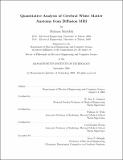| dc.contributor.advisor | W. Eric L. Grimson, William M. Wells and Carl-Fredrik Westin. | en_US |
| dc.contributor.author | Maddah, Mahnaz | en_US |
| dc.contributor.other | Massachusetts Institute of Technology. Dept. of Electrical Engineering and Computer Science. | en_US |
| dc.date.accessioned | 2009-06-25T20:34:38Z | |
| dc.date.available | 2009-06-25T20:34:38Z | |
| dc.date.copyright | 2008 | en_US |
| dc.date.issued | 2008 | en_US |
| dc.identifier.uri | http://hdl.handle.net/1721.1/45614 | |
| dc.description | Thesis (Ph. D.)--Massachusetts Institute of Technology, Dept. of Electrical Engineering and Computer Science, 2008. | en_US |
| dc.description | This electronic version was submitted by the student author. The certified thesis is available in the Institute Archives and Special Collections. | en_US |
| dc.description | Includes bibliographical references (p. 165-177). | en_US |
| dc.description.abstract | In this thesis we develop algorithms for quantitative analysis of white matter fiber tracts from diffusion MRI. The presented methods enable us to look at the variation of a diffusion measure along a fiber tract in a single subject or a population, which allows important clinical studies toward understanding the relation between the changes in the diffusion measures and brain diseases, development, and aging. The proposed quantitative analysis is performed on a group of fiber trajectories extracted from diffusion MRI by a process called tractography. To enable the quantitative analysis we first need to cluster similar trajectories into groups that correspond to anatomical bundles and to establish the point correspondence between these variable-length trajectories. We propose a computationally-efficient approach to find the point correspondence and the distance between each trajectory to the prototype center of each bundle. Based on the computed distances we also develop a novel model-based clustering of trajectories into anatomically-known fiber bundles. In order to cluster the trajectories, we formulate an expectation maximization algorithm to infer the parameters of the gamma-mixture model that we built on the distances between trajectories and cluster centers. We also extend the proposed clustering algorithm to incorporate spatial anatomical information at different levels through hierarchical Bayesian modeling. We demonstrate the effectiveness of the proposed methods in several clinical applications. In particular, we present our findings in identifying localized group differences in fiber tracts between normal and schizophrenic populations. | en_US |
| dc.description.statementofresponsibility | by Mahnaz Maddah. | en_US |
| dc.format.extent | 177 p. | en_US |
| dc.language.iso | eng | en_US |
| dc.publisher | Massachusetts Institute of Technology | en_US |
| dc.rights | M.I.T. theses are protected by
copyright. They may be viewed from this source for any purpose, but
reproduction or distribution in any format is prohibited without written
permission. See provided URL for inquiries about permission. | en_US |
| dc.rights.uri | http://dspace.mit.edu/handle/1721.1/7582 | en_US |
| dc.subject | Electrical Engineering and Computer Science. | en_US |
| dc.title | Quantitative analysis of cerebral white matter anatomy from diffusion MRI | en_US |
| dc.type | Thesis | en_US |
| dc.description.degree | Ph.D. | en_US |
| dc.contributor.department | Massachusetts Institute of Technology. Department of Electrical Engineering and Computer Science | |
| dc.identifier.oclc | 320078252 | en_US |
